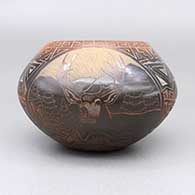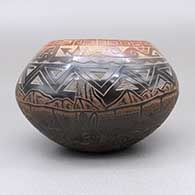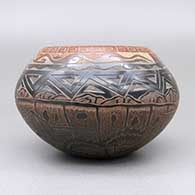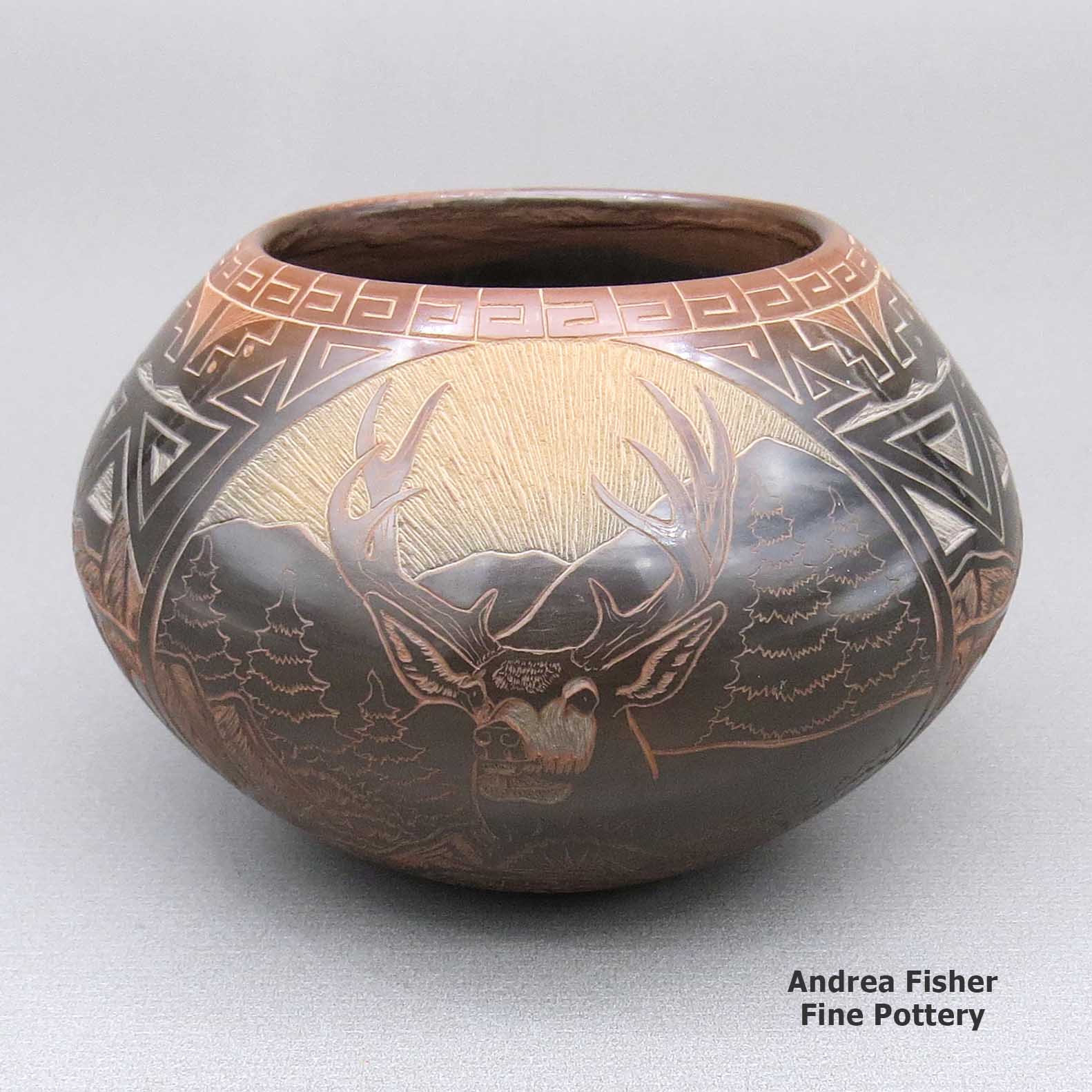
Santa Clara
$ 1150
nmsc3a050
Black jar with sienna rim and sgraffito deer, avanyu, rabbit, pueblo, and geometric design
3.5 in L by 3.5 in W by 2.25 in H
Condition: Very good
Signature: Kevin Naranjo Santa Clara Pueblo
Tell me more! Buy this piece!
(505) 986-1234 - www.andreafisherpottery.com - All Rights Reserved
Kevin Naranjo
Santa Clara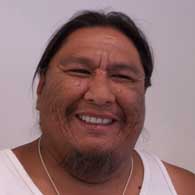
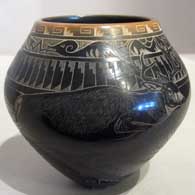
Born in 1972 at Santa Clara Pueblo, Kevin Naranjo was given a Tewa name meaning Turquoise Mountain. He says he was inspired to learn the ancient tradition of hand coiling pottery by the time he was four, that inspiration coming from his family and his love of nature.
Kevin was born into a family of famous potters, including Luther Gutierrez (his great-grandfather), Dolores Curran (a maternal aunt) and Geri Naranjo (his mother). Geri is renowned for her miniature sgraffito (fine line incised) pottery, the traditional methods of which she taught to both Kevin and his sister, Monica Naranjo Romero.
Specializing in hand coiled black/sienna sgraffito pottery, Kevin gathers his clay from sacred grounds within Santa Clara Pueblo. He digs and prepares the clay, hand-coils and shapes his forms, then lets them dry for a few days. Then he stone polishes the surfaces and ground fires his pottery using an oxygen-reduction process to make the black canvas for his designs. After firing, he etches the pot to create wonderful scenes of wildlife that live in the area of his home on Santa Clara.
The first piece he made as a child was a dinosaur. He remembers it well: it sparked an interest in molding animal figurines. That first inspiration and practice evolved until now his pottery embodies beautiful symmetry, graceful lines and finely executed sgraffito designs like as the avanyu (water serpent), kiva steps and the feather pattern. Additional figures such as bears, eagles, bighorn sheep, deer and elk are incorporated into backgrounds of pueblo ruins and mountain views.
Since 2001, Kevin has been collaborating with Tricia Pena from San Ildefonso Pueblo. Her grandfather, the late Encarnacion Pena, was a member of the original San Ildefonso School of Painters. Together Kevin and Tricia are passing the art of pottery making on to their children.
Kevin has consistently earned awards for his sgraffito and miniature pottery since starting to compete in 1994. Most recently, he received Best of Division for miniature sgraffito at the 2006 Santa Fe Indian Market.
Santa Clara Pueblo

Ruins at Puye Cliffs, Santa Clara Pueblo
Santa Clara Pueblo straddles the Rio Grande about 25 miles north of Santa Fe. Of all the pueblos, Santa Clara has the largest number of potters.
The ancestral roots of the Santa Clara people have been traced to the pueblos in the Mesa Verde region in southwestern Colorado. When that area began to get dry between about 1100 and 1300, some of the people migrated to the Chama River Valley and constructed Poshuouinge (about 3 miles south of what is now Abiquiu on the edge of the mesa above the Chama River). Eventually reaching two and three stories high with up to 700 rooms on the ground floor, Poshuouinge was inhabited from about 1375 to about 1475. Drought then again forced the people to move, some of them going to the area of Puye (on the eastern slopes of the Pajarito Plateau of the Jemez Mountains) and others to Ohkay Owingeh (San Juan Pueblo, along the Rio Grande). Beginning around 1580, drought forced the residents of the Puye area to relocate closer to the Rio Grande and they founded what we now know as Santa Clara Pueblo on the west bank of the river, between San Juan and San Ildefonso Pueblos.
In 1598 Spanish colonists from nearby Yunque (the seat of Spanish government near San Juan Pueblo) brought the first missionaries to Santa Clara. That led to the first mission church being built around 1622. However, the Santa Clarans chafed under the weight of Spanish rule like the other pueblos did and were in the forefront of the Pueblo Revolt of 1680. One pueblo resident, a mixed black and Tewa man named Domingo Naranjo, was one of the rebellion's ringleaders. When Don Diego de Vargas came back to the area in 1694, he found most of the Santa Clarans on top of nearby Black Mesa (with the people of San Ildefonso). An extended siege didn't subdue them so eventually, the two sides negotiated a treaty and the people returned to their pueblo. However, successive invasions and occupations by northern Europeans took their toll on the tribe over the next 250 years. The Spanish flu pandemic in 1918 almost wiped them out.
Today, Santa Clara Pueblo is home to as many as 2,600 people and they comprise probably the largest per capita number of artists of any North American tribe (estimates of the number of potters run as high as 1-in-4 residents).
Today's pottery from Santa Clara is typically either black or red. It is usually highly polished and designs might be deeply carved or etched ("sgraffito") into the pot's surface. The water serpent, ("avanyu"), is a traditional design motif of Santa Clara pottery. Another motif comes from the legend that a bear helped the people find water during a drought. The bear paw has appeared on their pottery ever since.
One of the reasons for the distinction this pueblo has received is because of the evolving artistry the potters have brought to the craft. Not only did this pueblo produce excellent black and redware, several notable innovations helped move pottery from the realm of utilitarian vessels into the domain of art. Different styles of polychrome redware emerged in the 1920's-1930's. In the early 1960's experiments with stone inlay, incising and double firing began. Modern potters have also extended the tradition with unusual shapes, slips and designs, illustrating what one Santa Clara potter said: "At Santa Clara, being non-traditional is the tradition." (This refers strictly to artistic expression; the method of creating pottery remains traditional).
Santa Clara Pueblo is home to a number of famous pottery families: Tafoya, Baca, Gutierrez, Naranjo, Suazo, Chavarria, Garcia, Vigil, Tapia - to name a few.



Santa Clara Pueblo at Wikipedia
Pueblos of the Rio Grande, Daniel Gibson, ISBN-13:978-1-887896-26-9, Rio Nuevo Publishers, 2001
Upper photo courtesy of Einar Kvaran, Creative Commons Attribution-Share Alike 3.0 Unported License
Ursulita Naranjo Family Tree
Disclaimer: This "family tree" is a best effort on our part to determine who the potters are in this family and arrange them in a generational order. The general information available is questionable so we have tried to show each of these diagrams to living members of each family to get their input and approval, too. This diagram is subject to change should we get better info.
- Ursulita Naranjo (1924-1988) and Alfred Naranjo
- Dolores Curran & Alvin Curran (San Juan)(1953-1999)
- Ursula Curran
- Geri Naranjo
- Kevin Naranjo (1972-)
- Monica Naranjo
- Alfred Ervin Naranjo & Jennifer Sisneros
- Alfred Naranjo (1980-)
Some of the above info is drawn from Pueblo Indian Pottery, 750 Artist Biographies, by Gregory Schaaf, © 2000, Center for Indigenous Arts & Studies
Other info is derived from personal contacts with family members and through interminable searches of the Internet.
Copyright © 1998-2024 by


